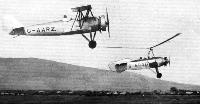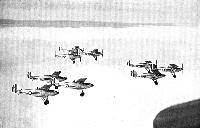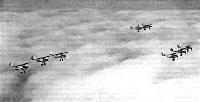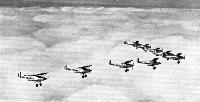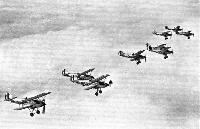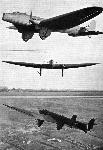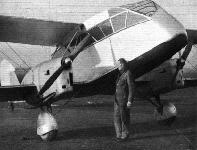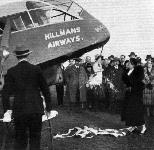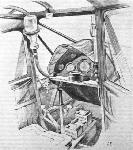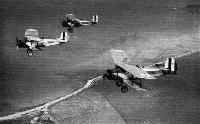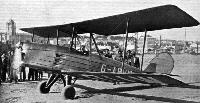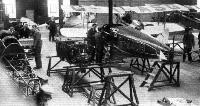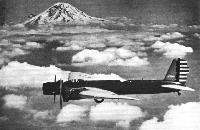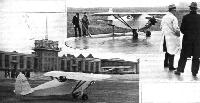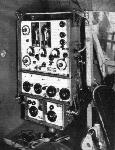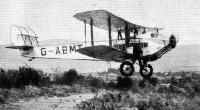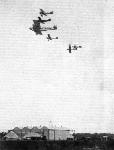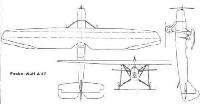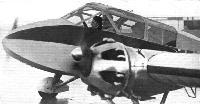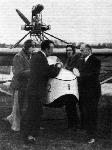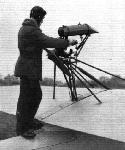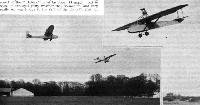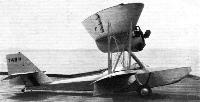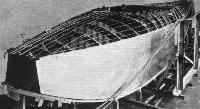Фотографии
-
Регистрационный номер: G-AARZ, G-ABGB The Avro 621 "Tutor" and the Autogiro of Sir Alan's Circus flying in typical Cape Town scenery.
Самолёты на фотографии: Avro Tutor/Sea Tutor/Prefect / Type 621/646/626 - Великобритания - 1929Cierva/Avro C.19 - Великобритания - 1929
-
Регистрационный номер: K2052 [2] SQUADRON FORMATION: No. 25 (Fighter) Squadron flying their interceptor Hawker "Furies" (Rolls-Royce "Kestrels") above the clouds.
Самолёты на фотографии: Hawker Fury - Великобритания - 1931
-
ACCURACY: No. 25 F.S. in squadron formation with nights in line abreast.
Самолёты на фотографии: Hawker Fury - Великобритания - 1931
-
SQUADRON "V": No. 25 (Fighter) Squadron can fly their "Furies" in any formation.
Самолёты на фотографии: Hawker Fury - Великобритания - 1931
-
Регистрационный номер: K2052 [2], K2054 NO. 25 (FIGHTER) SQUADRON (HAWKER "FURIES" AND ROLLS-ROYCE "KESTRELS"): "Flights Line Abreast" above Hawkinge.
Самолёты на фотографии: Hawker Fury - Великобритания - 1931
-
Renard R 31 2-Seater Reconnaissance Rolls-Royce "Kestrel" Engine
Самолёты на фотографии: Renard R.31 / R.32 - Бельгия - 1932
-
The Westland "Wapiti" has widely been used by the R.A.F. for photographic duties in many parts of the Empire.
Самолёты на фотографии: Westland Wapiti - Великобритания - 1927
-
Регистрационный номер: K1695 BREAKING NEW GROUND: In the design of the new Fairey night bomber (two Rolls-Royce "Kestrel") every effort has been made to achieve aerodynamic efficiency, and for the first time in the history of British aviation a night bomber has been produced as a cantilever monoplane. The size of the machine may be gauged from that of the visible crew. When these photographs were taken the machine was piloted by Flt. Lt. Staniland, Fairey's Chief Test Pilot.
Самолёты на фотографии: Fairey Hendon - Великобритания - 1930
-
Регистрационный номер: G-ACAN [3] Самолёты на фотографии: De Havilland Dragon / D.H.84 - Великобритания - 1932
-
THE DE HAVILLAND "DRAGON": This view of the nose and engines illustrates the good view obtained by the pilot, and the careful fairing of the "Gipsy Major" engines. The undercarriage is of low drag.
Самолёты на фотографии: De Havilland Dragon / D.H.84 - Великобритания - 1932
-
Регистрационный номер: G-ACAN [3] ZONK! Our photographer catches Amy in the act of wasting precious champagne. She excused her action by naming the first Hillman's Airways "Dragon" - Maylands.
Самолёты на фотографии: De Havilland Dragon / D.H.84 - Великобритания - 1932
-
Регистрационный номер: G-ACAN [3] TRULY COMMERCIAL: This, the first D.H. "Dragon," has been added to the fleet of machines used by Mr. Hillman at his aerodrome at Romford. Its capacious cabin should make it a paying proposition for commercial operation.
Самолёты на фотографии: De Havilland Dragon / D.H.84 - Великобритания - 1932
-
W/SPAN^2: Reduction of induced drag has been aimed at by using wings of large span, giving low span loading.
Самолёты на фотографии: De Havilland Dragon / D.H.84 - Великобритания - 1932
-
Самолёты на фотографии: De Havilland Dragon / D.H.84 - Великобритания - 1932
-
SOME STRUCTURAL DETAILS OF THE D.H.84 ("DRAGON"): As the machine is of very simple and straightforward construction generally, the greatest interest centres around the steel tube structures carrying the engines and petrol tanks. The sketch shows the part of these which can be regarded as being part of the wing structure.
Самолёты на фотографии: De Havilland Dragon / D.H.84 - Великобритания - 1932
-
SOME STRUCTURAL DETAILS OF THE D.H.84 ("DRAGON"): The details being more clearly shown in the small sketches.
Самолёты на фотографии: De Havilland Dragon / D.H.84 - Великобритания - 1932
-
D.H.84 2 Gipsy Major Engines
Самолёты на фотографии: De Havilland Dragon / D.H.84 - Великобритания - 1932
-
HOME FROM THE CAPE: Mrs. J. A. Mollison landing at Croydon in her "Puss Moth" "Desert Cloud" on December 18.
Самолёты на фотографии: De Havilland Puss Moth / D.H.80 - Великобритания - 1929
-
The Bert Hinkler's de Havilland "Puss Moth" on which he flew from New York to South America, across the South Atlantic, and from West Africa back to England.
Самолёты на фотографии: De Havilland Puss Moth / D.H.80 - Великобритания - 1929
-
It would be difficult to show, in one drawing, a greater number of details than those which Mr. Max A. Millar has included in this part-sectioned view of Mrs. Mollison's "Puss Moth" "Desert Cloud." The equipment differs considerably from that of Hinkler's machine.
Самолёты на фотографии: De Havilland Puss Moth / D.H.80 - Великобритания - 1929
-
COMPRESSION-IGNITION: Two views of the Rolls-Royce "Condor" installed in a Hawker "Horsley." Test flights are about to commence.
Самолёты на фотографии: Hawker Horsley / Dantorp - Великобритания - 1925
-
Регистрационный номер: K1175 THE SHORES OF SHEPPEY: Three Armstrong-Whitworth "Atlases" of Oxford University Air Squadron out on the prowl.
Самолёты на фотографии: Armstrong Whitworth Atlas / Ajax - Великобритания - 1925
-
Регистрационный номер: G-ABUW The Blackburn "B.2" Trainer taking off from the football field en route for Cintra.
Самолёты на фотографии: Blackburn B-2 - Великобритания - 1931
-
The "B.2" being unloaded from the ex-rum runner "Fayal" and slung into the barge in which it made the journey down the Tagus to the seaplane base.
Самолёты на фотографии: Blackburn B-2 - Великобритания - 1931
-
Регистрационный номер: G-AAOB, G-AASG FOR REPAIR AND MAINTENANCE: The well-equipped workshops at Hanworth (now under the charge of Capt. E. D. Ayre) have been increasingly busy lately overhauling aircraft for C's. of A. and on general repair work.
G-AAOB - Blackburn Bluebird IV; G-AASG - DH.60G Gipsy MothСамолёты на фотографии: Blackburn Bluebird / L.1 - Великобритания - 1924De Havilland Gipsy Moth / Moth X - Великобритания - 1928
-
SAYING HELLO! TO THE PEAKS: New low-wing, all-metal, twin-engined Boeing bomber caught against the impressive background of Mount Rainier, 14,408 ft. above sea level. Seven of these planes, hailed as the fastest of their type in the world, are being built for the U.S. Army Air Corps by the Boeing Airplane Company of Seattle.
Самолёты на фотографии: Boeing B-9 - США - 1931
-
Регистрационный номер: G-ABRE AN UNSUCCESSFUL RIVAL: Mr. Victor Smith, the young South African airman sets out from Croydon on December 15 to beat Mrs. Mollison's Cape record. He had hard luck, however, and was forced down at St. Malo, while, when taking off for England on December 16, he crashed, damaging his Comper "Swift," but fortunately without hurt to himself.
Самолёты на фотографии: Comper Swift / CLA.7 - Великобритания - 1930
-
Marconi Type A.D. 37A/38A, combined medium and short wave transmitter and receiver and the Marconi-Robinson directional attachment, to be installed in the first four Armstrong-Whitworth "Atalanta" aircraft engaged on the Cairo-Cape Town air route.
Самолёты на фотографии: Armstrong Whitworth Atalanta / A.W.15 - Великобритания - 1932
-
Регистрационный номер: G-ABMT THE CIRCUS AT THE CAPE: The D.H. 66 lands, apparently in rough ground, at the Cape Airport. Actually, the surface of the aerodrome is quite smooth.
Самолёты на фотографии: De Havilland Hercules / D.H.66 - Великобритания - 1926
-
THE CIRCUS AT THE CAPE: Six of Sir Alan Cobham's machines flying in formation, led by the D.H.66, over Cape Town.
Самолёты на фотографии: De Havilland Hercules / D.H.66 - Великобритания - 1926
-
Регистрационный номер: D-2295 Самолёты на фотографии: Focke-Wulf FW.47 - Германия - 1931
-
THE PILOT'S COCKPIT: The instrument equipment is unusually extensive. Below and to the right of the wheel can be seen the oil temperature control handle.
Самолёты на фотографии: Focke-Wulf FW.47 - Германия - 1931
-
Focke-Wulf A 47
Самолёты на фотографии: Focke-Wulf FW.47 - Германия - 1931
-
Регистрационный номер: G-AABI, G-ABAD, G-ABUZ LONDON'S NEWEST AIRPORT: A Monospar and two "Moths" arriving above the recently opened aerodrome and seaplane base at Gravesend.
Самолёты на фотографии: De Havilland Gipsy Moth / Moth X - Великобритания - 1928General Aircraft Monospar ST-4 - ST-12 - Великобритания - 1932
-
MONOSPAR CARRIES BOURBON PRINCE: Seated on the right of Capt. R. Stocken in the Monospar, is Prince Sixte de Bourbon-Parme, who, accompanied by Le Comte de Beam (in rear seat) returned to Paris in this machine on December 22, after lecturing before the Royal Geographical Society in London.
Самолёты на фотографии: General Aircraft Monospar ST-4 - ST-12 - Великобритания - 1932
-
STARTING UP: By pulling a wire wound round a drum behind the engine.
Самолёты на фотографии: Kronfeld Drone - Великобритания - 1932
-
BABY TALK: From left to right, Capt. E. D. Ayre, the Master of Sempill, Mr. Lowe-Wylde, and Mr. Gordon England.
Самолёты на фотографии: Kronfeld Drone - Великобритания - 1932
-
THE POWER UNIT: A close-up showing the little Douglas on its mounting and the petrol tank above it.
Самолёты на фотографии: Kronfeld Drone - Великобритания - 1932
-
THE "AIR BABIES" IN FLIGHT: On the left, the two "in formation," and on the right Capt. Ayre in the air.
Самолёты на фотографии: Kronfeld Drone - Великобритания - 1932
-
Регистрационный номер: VH-UPB, ZK-ABW FOR NEW ZEALAND SERVICE: A Saro "Windhover" flying boat used for the Victoria-Tasmania trip.
Самолёты на фотографии: Saunders-Roe Windhover / A.21 - Великобритания - 1930
-
Регистрационный номер: 749N Самолёты на фотографии: Savoia-Marchetti / SIAI S.56 - Италия - 1924
-
THE HULL OF THE BB.1: Sides and bottom were assembled as units and then welded to the frames and stringers. The latter are of U-section. Watertight joints were obtained by running solder into the gaps between welds.
Самолёты на фотографии: Savoia-Marchetti / SIAI S.56 - Италия - 1924
-
SHOT-WELDED ENTIRELY IN STAINLESS STEEL: The BB.1 Amphibian in skeleton. The machine is coming to this country shortly.
Самолёты на фотографии: Savoia-Marchetti / SIAI S.56 - Италия - 1924
-
Регистрационный номер: G-ACEG A NEW "SPARTAN" TWO-SEATER: This little machine has been built as a "full-scale" experiment, carried out as cheaply as possible, in order to provide the fullest possible information before going into production. The machine will be flown strenuously for a time so as to make sure that when, later on, production is started, there shall be no "snags." It is a side-by-side two-seater, fitted with Pobjoy "R" engine, and the fuselage of the experimental machine is of plywood construction, while the wings are the outer portions of the Stieger Monospar S.T.4. The first test flights, carried out by Col. Strange, Capt. Scott and Mr. Ash on Wednesday of last week, were entirely successful. The loaded weight with pilot, passenger, luggage, and three hours' fuel is 1,300 lb. The machine was designed by Mr. H. E. Broadsmith.
Самолёты на фотографии: Spartan Clipper - Великобритания - 1932
-
Регистрационный номер: G-ABWL FALLING SAFELY: Mr. Raymond Quilter, who makes the "G-Q" parachute, especially designed for private owners, is here seen making a drop for test purposes, from one of the Brooklands Flying School "Moths." Note the left hand raised to adjust his goggles and the position of the body which will allow the chute to clear the legs.
Самолёты на фотографии: De Havilland Gipsy Moth / Moth X - Великобритания - 1928
-
FROM KUALA LUMPUR: Mr. J. R. Hibert warms up his "Gipsy" engine prior to his departure from the Kuala Lumpur Flying Club's aerodrome for Singapore during his recent flight from Heston to Australia.
Самолёты на фотографии: De Havilland Gipsy Moth / Moth X - Великобритания - 1928
-
THE LIORE & OLIVIER AUTOGIRO (POBJOY "R" ENGINE): This sketch by Jean Gaudefroy, reproduced by courtesy of our French contemporary "L'Aeronautique," shows most of the structural details. The fore-and-aft control is guided by the curved rail A, and can be locked in any position by the knurled knob B. It was through taking the machine off with the control locked that the fatal crash occurred.
Самолёты на фотографии: Liore et Olivier CL.10 - Франция - 1932
Статьи
- Flight
